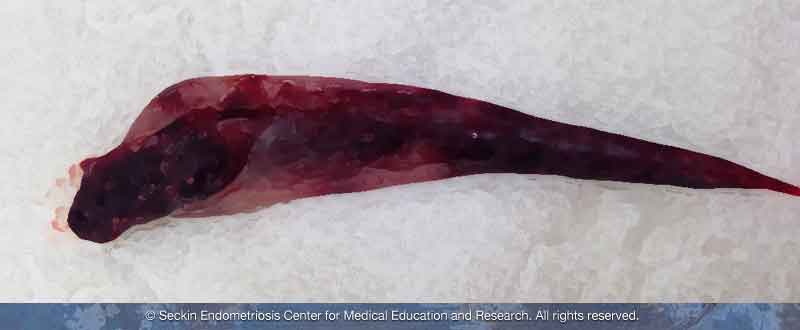Menstrual clots are lumps of coagulated blood or tissue. They are discharged from the uterus during menstruation when the lining of the uterus or endometrium sheds and is expelled from the uterus through the cervix.
Normally, the body produces anticoagulants or blood thinners to allow the thickened endometrium fragments and blood mixture to pass more freely through the cervix and leave the body. However, sometimes, the body is not able to produce enough thinning agents, causing blood clots to form.
Menstrual clots resemble pieces of mashed-up red fruit. They can be bright red or burgundy and may vary in size. They are usually mixed with liquid blood. The longer the blood stays inside the uterus, the darker it is in color, and the likelier it is to form clots.

Causes of menstrual clots
Blood clot formation is the body’s way of controlling bleeding. Blood cells called platelets play an important role in blood clot formation. They release chemicals that start the “clotting cascade.” The fibrin protein is the last step in this cascade, which crosslinks and forms a mesh-like structure that results in a clot.
Platelets can produce these clotting factors. This occurs during menstruation, as well as because of an injury to a blood vessel wall.
Get a Second Opinion
Our endometriosis specialists are dedicated to providing patients with expert care. Whether you have been diagnosed or are looking to find a doctor, they are ready to help.Our office is located on 872 Fifth Avenue New York, NY 10065.
You may call us at (212) 988-1444 or have your case reviewed by clicking here.
Menstrual clots and heavy periods
The normal menstrual cycle lasts 25 to 32 days. A normal flow lasts between four and seven days and may be accompanied by blood clots. A normal period should normally cause mild to moderate discomfort beginning the first day and then subside.
A period is considered heavy if it soaks through a pad or tampon every hour for several hours or if it lasts for over seven days. Large clots in period blood are also considered signs of heavy periods. Moreover, heavy periods can cause constant pain in the lower abdomen.
Heavy menstrual bleeding can negatively affect a woman’s quality of life and lead to other conditions such as anemia where the body lacks enough healthy red blood cells that can carry oxygen to different organs and tissues in the body. Anemia can make a person feel weak and tired.
Menstrual clots and disease
Blood clots during a period can be normal or a sign of an underlying problem such as:
- a blockage in the uterus
- fibroids or non-cancerous growths in the wall of the uterus
- hormonal imbalance
- a miscarriage
Menstrual blood clots can also indicate the presence of more serious conditions such as:
- endometriosis
- adenomyosis
- cancer
Should I worry?
Clots in menstrual blood are considered normal if they are quarter-sized or smaller and only occur occasionally. However, if they frequently occur (more than three times in a row) accompanied by heavy periods and are larger than a quarter, you should seek medical advice.
Menstrual clots and endometriosis
Endometriosis is usually accompanied by heavy bleeding during a woman’s period and chronic pelvic pain. This is because the endometrium-like tissue that has grown outside the uterus reacts to the hormones secreted from the ovaries in the same way as the normal endometrium and starts to bleed.
Treatment
Hormonal medications such as the contraceptive pill can help regulate heavy bleeding and reduce the formation of blood clots. These work by inhibiting the growth of the endometrium. An intrauterine device (IUD) that releases the hormone progestin can also help.
Other treatment options include Cyklokapron and Lysteda. These medications stop blood clots from breaking down and therefore may reduce heavy menstruation. Likely less blood will pool in the uterus and menstrual clot formation will diminish.
Laparoscopic surgery often used both to diagnose and treat endometriosis, can also treat heavy bleeding and the formation of blood clots during periods.
Our approach
Endometriosis is associated with heavy periods, prolonged menstrual flow, and large clots. We believe that a transvaginal sonogram, and, if needed, hysteroscopy and endometrial biopsy are necessary for diagnosis. It is also necessary to rule out the diagnoses of myoma, uterine fibroid, polyp, endometrial hyperplasia, and endometrial cancer.
Patient story
“My research led me to locate an excision specialist, Dr. Seckin. I had excision surgery with Dr. Seckin in March 2015. I had advanced endometriosis removed in 18 places, including my appendix, intestines, ovary, and uterus. It turns out that the cyst was the least of my problems! Dr. Seckin was wonderful throughout my experience.” —M. Wilson
Get a Second Opinion
Our endometriosis specialists are dedicated to providing patients with expert care. Whether you have been diagnosed or are looking to find a doctor, they are ready to help.Our office is located on 872 Fifth Avenue New York, NY 10065.
You may call us at (646) 960-3080 or have your case reviewed by clicking here.
Dr. Seckin is an endometriosis specialist and women’s reproductive health advocate. He has been in private practice for over 30 years at Lenox Hill Hospital with a team of highly skilled personnel.
Dr. Seckin specializes in advanced laparoscopic procedures and is recognized for his expertise in complex cases of deep infiltrating endometriosis of the pelvis. He is particularly dedicated to performing fertility-preserving surgeries on cases involving the ovaries.
He has developed patented surgical techniques, most notably the “Aqua Blue Excision” technique for a better visualization of endometriosis lesions. His surgical techniques are based on precision and microsurgery, emphasizing organ and fertility preservation, and adhesion and pain prevention.
Dr. Seckin is considered a pioneer and advocate in the field of endometriosis.
